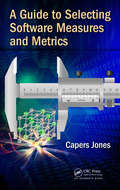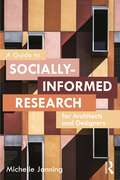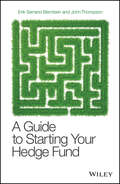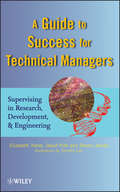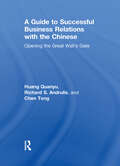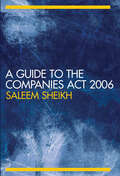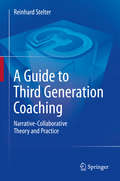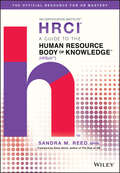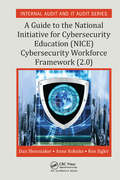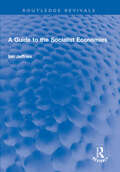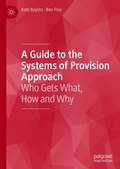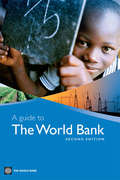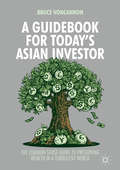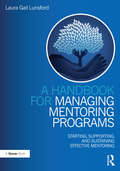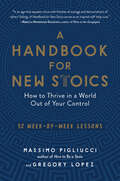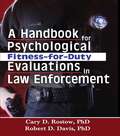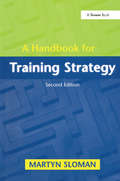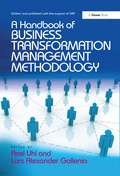- Table View
- List View
A Guide to SME Financing
by David MunroA Guide to SME Finance is a brief guide to designing and implementing a SME finance program within a commercial bank or other financial institution, such as an NGO.
A Guide to Selecting Software Measures and Metrics
by Capers JonesGoing where no book on software measurement and metrics has previously gone, this critique thoroughly examines a number of bad measurement practices, hazardous metrics, and huge gaps and omissions in the software literature that neglect important topics in measurement. The book covers the major gaps and omissions that need to be filled if data about software development is to be useful for comparisons or estimating future projects. Among the more serious gaps are leaks in reporting about software development efforts that, if not corrected, can distort data and make benchmarks almost useless and possibly even harmful. One of the most common leaks is that of unpaid overtime. Software is a very labor-intensive occupation, and many practitioners work very long hours. However, few companies actually record unpaid overtime. This means that software effort is underreported by around 15%, which is too large a value to ignore. Other sources of leaks include the work of part-time specialists who come and go as needed. There are dozens of these specialists, and their combined effort can top 45% of total software effort on large projects. The book helps software project managers and developers uncover errors in measurements so they can develop meaningful benchmarks to estimate software development efforts. It examines variations in a number of areas that include: Programming languages Development methodology Software reuse Functional and nonfunctional requirements Industry type Team size and experience Filled with tables and charts, this book is a starting point for making measurements that reflect current software development practices and realities to arrive at meaningful benchmarks to guide successful software projects.
A Guide to Socially-Informed Research for Architects and Designers
by Michelle JanningThis book offers an efficient set of step-by-step tips and overarching lessons about how to gather useful, meaningful, and socially-informed data about clients’ and other stakeholders' experiences in architecture and interior design professions. In this guide, author Michelle Janning helps the design professional conduct ongoing evaluation of design projects, create useful pre- and post-design evaluations, frame effective questions for improved future design, involve various stakeholders in the research process, and focus on responsible and evidence-based human-centered design to improve the relationship between design and people’s experiences. Examining a variety of both large- and small-scale project examples from different institutional realms, including healthcare sites, schools, residences, eating establishments, museums, and theaters, this book highlights not only the overlap in these types of projects but also the differences between project sizes that may impact the methods used in any given project. It also offers tools for how to communicate design success to audiences that include potential clients, occupants, and other designers. A Guide to Socially-Informed Research for Architects and Designers is a go-to reference for design professionals interested in using accessible social scientific methods to gather essential and practical information from people who occupy the spaces they design and to do so in an ethical, inclusive, and socially-informed way in order to enhance social sustainability in the built environment.
A Guide to Sources of Information on the National Labor Relations Board (Research and Information Guides in Business, Industry and Economic Institutions)
by Gordon T. Law M. P. CatherwoodA concise history of the board in the U.S. from its inception in 1935, including an overview of current case law, and a bibliographic essay of selected secondary literature about the board.
A Guide to Starting Your Hedge Fund
by John Thompson Erik Serrano BerntsenSuccessful hedge fund investing begins with well-informed strategy A Guide to Starting Your Hedge Fund is a practical, definitive "how-to" guide, designed to help managers design and launch their own funds, and to help investors select and diligence new funds. The first book to examine the practical aspects of setting up and operating funds with a focus on energy commodity markets, this book scrutinises the due diligence process and comprehensively reviews the opportunities and risks of all energy commodity markets as hedge fund investments. Extensive planning and strategy advice prove invaluable to prospective fund managers and investors alike, and detailed discussion of the markets' constraints help inform procedural decisions. Readers gain insight into practical matters including legal and commercial structures, due diligence, fund raising, operations, and more, allowing them to construct a concrete investment plan before ever touching a penny. Asset managers are looking to energy commodities to provide attractive uncorrelated - if volatile - returns. These high returns, however, are accompanied by high risk. Few investors have experience evaluating these investment opportunities, and few prospective fund managers understand the market fundamentals and their associated risks. This book provides the answers sorely lacking in hedge fund literature, giving investors and fund managers the background they need to make smarter decisions. Understand the markets' structures, opportunities, and risks Develop a comprehensive, well-informed investment strategy Conduct thorough due diligence with a detailed plan Examine the practical aspects of fund raising, legal and tax structure, and more Oil has long been traded by hedge funds, but electricity, the fuels that generate electricity, and the environmental products like emissions allowances and weather derivatives have become the new "hot" investment strategies. These high returns come with higher risk, but A Guide to Starting Your Hedge Fund ensures participants have essential information at their disposal.
A Guide to Success for Technical Managers
by Elizabeth Treher Timothy Carr Steven Jacobs David PiltzSupervisory Skills for the Technical Manager: A Guide to Success focuses exclusively on the dynamics of being a technical manager such as a scientist, programmer, or engineer. An R&D environment demands modified management techniques and this book explores how to do so. Drawing of years of experience to provide technical managers with various tools and ways to apply them in supervisory situation, this essential title includes exercises, templates and checklists to accelerate their uses and applications on the job. In addition, case studies are included throughout to thoroughly explain and explore the concepts discussed.Key topics include handing the transition to supervising others in research and development, the characteristics needed to motivate personnel in a R&D environment as compared to other areas of business are detailed. The pitfalls and challenges of managing technical personnel, how delegating can build an effective team that can produce superior results, and how to monitor the work of previously independent personnel are also discussed.
A Guide to Successful Business Relations With the Chinese: Opening the Great Wall's Gate
by Huang Quanyu Chen Tong Richard S AndrulisIntroduces and analyzes the Chinese people, their ideas, behavior, and cultural roots. It not only provides a sufficient theoretical basis for understanding this population, but also focuses on the various vivid practical experiences of everyday and business life. A Guide to Successful Business Relations With the Chinese alters Western business people’s perception of the Chinese people and improves their ability and skill in creating harmonious relationships with Chinese managers, colleagues, and subordinates on business and personal levels.
A Guide to Sustainable Corporate Responsibility: From Theory to Action
by Caroline D. Ditlev-SimonsenThis open access book discusses the challenges and opportunities faced by companies in an age that increasingly values sustainability and demands corporate responsibility. Beginning with the historical development of corporate responsibility, this book moves from academic theory to practical application. It points to ways in which companies can successfully manage their transition to a more responsible, sustainable way of doing business, common mistakes to avoid and how the UN Sustainable Development Goals are integral to any sustainability transformation. Practical cases illustrate key points. Drawing on thirty years of sustainability research and extensive corporate experience, the author provides tools such as a Step-by-Step strategic guide on integrating sustainability in collaboration with stakeholders including employees, customers, suppliers and investors. The book is particularly relevant for SMEs and companies operating in emerging markets. From a broader perspective, the value of externalities, full cost pricing, alternative economic theories and circular economy are also addressed.
A Guide to Teaching Young Adults About Money
by Rae SimonsParents and teachers can help young people understand the complex world of money and finance--and give them a head start in establishing good financial habits. This guide offers parents and educators resources and discussion topics for materials covered in The Junior Library of Money.
A Guide to The Companies Act 2006
by Saleem SheikhAn easy to use guide to the Companies Act 2006 and packed full of helpful features, this book provides detailed commentary on the new Companies Act. Offering a chapter by chapter analysis of the legal and practical implications of the Act, the author traces the background to the act, considering the various Consultation Documents and White Papers issued by the Government, the proposals for company law reform and their culmination in the Company Law Reform Act. It contains: helpful checklists for the busy practitioner section by section commentary useful appendices of materials and extracts on an accompanying Companion Website. This is an invaluable and handy resource for undergraduate students and practitioners studying or working in business and company law.
A Guide to The Uncitral Arbitration Rules
by Christopher Kee Clyde Croft Christopher Kee Jeffrey Waincymer Clyde CroftThe first version of the UNCITRAL Arbitration Rules was endorsed by the General Assembly of the United Nations in December 1976. Now considered one of UNCITRAL's greatest successes, the rules have had an extraordinary impact on international arbitration as both instruments in their own right and as guides for others. The Iran-US Claims Tribunal, for example, employs a barely modified version of the rules for all claims, and many multilateral and bilateral foreign investment treaties adopt the UNCITRAL Rules as an arbitral procedure. The Rules are so pervasive and the consequences of the new version potentially so significant that they cannot be ignored. This commentary on the Rules brings the official documents together in one volume and includes the insights and experiences of the Working Group that are not included in the official reports.
A Guide to Third Generation Coaching: Narrative-Collaborative Theory and Practice
by Reinhard StelterThis book proposes third generation coaching in a form where the coach and the coaches are less concerned with solutions and more concerned with creating space for (self-)reflection through collaborative practices. Offering a revisited and innovative approach to coaching psychology, advantageous for learners and practitioners alike. It marks a new trend in coaching and has a special profile, based on the acknowledgement of changes in society, learning and knowledge production, as well as leadership. The author' s concept of coaching distinguishes itself from the existing models (pop coaching , GROW model, etc) by offering a fresh analysis of our society - a society that is characterised by diversification, identity challenges, abolition of the monopoly of knowledge, lifelong learning, the necessity for self-reflection, etc. These societal changes are the basis for the existence of coaching and its prevalence, but they must also be the foundation for the way we employ coaching.
A Guide to the Human Resource Body of Knowledge (HRBoK)
by Sandra M. ReedAn essential reference for HR professionals A Guide to the HR Body of Knowledge (HRBoKTM) from HR Certification Institute (HRCI®) is an essential reference book for HR professionals and a must-have guide for those who wish to further their expertise and career in the HR field. This book will help HR professionals align their organizations with essential practices while also covering the Core Knowledge Requirements for all exams administered by HRCI. Filled with authoritative insights into the six areas of HR functional expertise: Business Management and Strategy; Workforce Planning and Employment; Human Resource Development; Compensation and Benefits; Employee and Labor Relations; and Risk Management, this volume also covers information on exam eligibility, and prep tips. Contributions from dozens of HR subject matter experts cover the skills, knowledge, and methods that define the profession's best practices. Whether used as a desk reference, or as a self-assessment, this book allows you to: Assess your skill set and your organization's practices against the HRCI standard Get the latest information on strategies HR professionals can use to help their organizations and their profession Gain insight into the body of knowledge that forms the basis for all HRCI certification exams As the HR field becomes more diverse and complex, HR professionals need an informational "home base" for periodic check-ins and authoritative reference. As a certifying body for over four decades, HRCI has drawn upon its collective expertise to codify a standard body of knowledge for the field. The HRBoK is the definitive resource that will be your go-to HR reference for years to come.
A Guide to the National Initiative for Cybersecurity Education: A Guide To The National Initiative For Cybersecurity Education (nice) Framework (2. 0) (Security, Audit and Leadership Series)
by Dan Shoemaker Anne Kohnke Ken SiglerA Guide to the National Initiative for Cybersecurity Education (NICE) Cybersecurity Workforce Framework (2.0) presents a comprehensive discussion of the tasks, knowledge, skill, and ability (KSA) requirements of the NICE Cybersecurity Workforce Framework 2.0. It discusses in detail the relationship between the NICE framework and the NIST’s cybersecurity framework (CSF), showing how the NICE model specifies what the particular specialty areas of the workforce should be doing in order to ensure that the CSF’s identification, protection, defense, response, or recovery functions are being carried out properly. The authors construct a detailed picture of the proper organization and conduct of a strategic infrastructure security operation, describing how these two frameworks provide an explicit definition of the field of cybersecurity. The book is unique in that it is based on well-accepted standard recommendations rather than presumed expertise. It is the first book to align with and explain the requirements of a national-level initiative to standardize the study of information security. Moreover, it contains knowledge elements that represent the first fully validated and authoritative body of knowledge (BOK) in cybersecurity. The book is divided into two parts: The first part is comprised of three chapters that give you a comprehensive understanding of the structure and intent of the NICE model, its various elements, and their detailed contents. The second part contains seven chapters that introduce you to each knowledge area individually. Together, these parts help you build a comprehensive understanding of how to organize and execute a cybersecurity workforce definition using standard best practice.
A Guide to the Socialist Economies: A Guide (Routledge Revivals)
by Ian JeffriesFirst published in 1990, A Guide to the Socialist Economies explores the evolution of a variety of economic systems in the socialist world and highlights major problems facing fourteen countries – Albania, Bulgaria, China, Cuba, Czechoslovakia, the GDR, Hungary, North Korea, Mongolia, Poland, Romania, the Soviet Union, Vietnam and Yugoslavia –against a background of continuous change, characterized by such events as the Berlin blockade, the Korean war, the Hungarian revolution and the invasion of Czechoslovakia. The traditional Soviet economic model is studied in detail as the basic system adopted by or imposed upon all of these countries. A separate chapter is devoted to foreign trade in general and Comecon in particular, while each of the country studies deals with the political and economic background, economic reforms (including industry, agriculture, the financial system and foreign trade and capital) and the private sector. The book provides information on the economic institutions of all the individual countries which is invaluable if the various courses of reform each country has engaged upon are to be understood. Historical material supplements contemporary information in a work which is to be an essential reference for anyone engaged in a study of, or trade with, the socialist countries.
A Guide to the Systems of Provision Approach: Who Gets What, How and Why
by Ben Fine Kate BaylissUnderstanding consumption requires looking at the systems by which goods and services are provided – not just how they are produced but the historically evolved structures, power relations and cultures within which they are located. The Systems of Provision approach provides an interdisciplinary framework for unpacking these complex issues. This book provides a comprehensive account of the Systems of Provision approach, setting out core concepts and theoretical origins alongside numerous case studies. The book combines fresh understandings of everyday consumption using examples from food, housing, and water, with implications for society’s major challenges, including inequality, climate change, and prospects for capitalism. Readers do not require prior knowledge across the subject matter covered but the text remains significant for accomplished researchers and policymakers, especially those interested in the messy real world realities underpinning who gets what, how, and why across public and private provision in global, national, and historical contexts.
A Guide to the World Bank
by World BankThe World Bank Group is a vital source of financial and technical assistance to developing countries around the world. Its focus is on helping the poorest people in the poorest countries by using its financial resources, staff, and extensive experience to aid countries in reducing poverty, increasing economic growth, and improving quality of life. In partnership with more than 100 developing countries, the Bank Group is striving to improve health and education, fight corruption, boost agricultural support, build roadsand ports, and protect the environment. Other projects are aimed at rebuilding war-torn countries or regions, providing basic services such as access to clean water, and encouraging investments that create jobs. In addition to this critical groundwork around the world, various parts of the World Bank Group are involved in activities ranging from conducting economic research and analysis to providing financial and advisory services to governments and private enterprises. This completely revised and updated second edition provides an accessible and straightforward overview of the World Bank Group's history, organization, mission, and purpose. Additionally, for those wishing to delve further into subjects of particular interest, the book guides readers to sources containing more detailed information, including annual reports, Web sites, publications, and e-mail addresses for various departments. It also provides information on how to work for or do business with the World Bank. A good introduction for anyone interested in understanding what the World Bank Group does and how it does it, this book shows readers who want to learn more where to begin.
A Guidebook for 5GtoB and 6G Vision for Deep Convergence (Management for Professionals)
by Pengfei SunThis book aims to provide the industrial upgrading and business scenario improved and boosted by 5G, as well as to forecast the typical industry application with a 6G vision. At the beginning of the book, it builds an overview of how 5G stimulates industrial transformation in the global digitalization wave, involving its commercial use, policy support, and application development around the world. Also it summarizes the main challenges of 5GtoB in large-scale replication from the perspective of methodology and deduce its development path and future form oriented to XtoB. The author demonstrates the typical applications of 5G in key industries based on a large number of practices and propose common capabilities and essential components for large-scale replication, and details the progress in the convergence of 5GtoB and industry standards. It presents the 6G vision and innovative ToB enabling technologies and describe key technologies, including semantic communication, on-purpose network, and cell-free ultra-massive cooperative MIMO. As conclusion, it forecasts the typical industry applications of 6G, such as metaverse, man–machine interaction, and hyper-connected future city.
A Guidebook for Today's Asian Investor: The Common Sense Guide to Preserving Wealth in a Turbulent World
by Bruce VonCannonThis book is the first to directly address Asia's new rich with an easy-to-follow guide to investment and the world of global finance. There are currently approximately 15 million high net worth households in the world today, a number that is growing by 900,000 new millionaires in the world each year. Many of the Asian new rich, however, lack even basic information about investment strategies and how to put their wealth to work. With rich experience in the private sector, Bruce Von Cannon makes it seem easy in this enjoyable and readable new book.
A Half-Deal
by Marco Di Maggio Carla Larangeira Pedro LevindoIn June 2020, XP and Ita faced intensified competition and tension in their partnership, with the latter owning a minority stake at XP. Two years earlier, in May 2017, Ita had announced it would acquire 49.9% of XP for $1.8 billion, followed by three additional stages leading to company control. Yet in August 2018, Brazil's Central Bank, partially barred the deal, stating Ita could become a minority shareholder.Tensions surfaced as soon as the deal was formalized, with both companies engaging in public attacks across several marketing campaigns, with Ita estimated to lose around $27 million a day to XP from client migration. Moreover, XP faced increased competition from emerging investment platforms that were gaining ground in Brazil s market. By mid-2020, XP s financial results had skyrocketed, taking in $190 million in net income and $743 million in total revenues. As Guilherme Benchimol, XP s CEO, looks ahead, he must define what strategies they should pursue to achieve further growth, considering competitive forces and market opportunities at hand.
A Handbook for Managing Mentoring Programs: Starting, Supporting and Sustaining
by Laura Gail LunsfordDespite the interest and pervasiveness of mentoring there has been little attention devoted to professionalizing mentoring for program managers in learning organizations, especially post-secondary institutions, and there are scant resources available for mentoring coordinators. This book fills that gap. Drawing on research on mentoring and coaching in psychology, education and organizations, this guide translates research into practice by helping program administrators learn more about the behaviors of mentoring, stages of mentoring relationships, elements of high quality relationships, and recognizing and avoiding dysfunctional ones. The book includes diagnostic surveys and case studies that coordinators might use in their programs and makes an important contribution to the literature on mentoring, providing a practical, up-to-date resource for those working in the field on how to set up, run, and evaluate their mentoring programs.
A Handbook for New Stoics: How To Thrive In A World Out Of Your Control--52 Week-by-week Lessons
by Massimo Pigliucci Gregory LopezA pragmatic philosophy more popular than ever—here are 52 ancient lessons to help you overcome adversity and find tranquility in the modern world Stress often comes from situations that are beyond our control—such as preparing for a meeting, waiting for test results, or arguing with a loved one. But we can control our response to these everyday tensions—through the wisdom and practice of Stoicism. Stoicism is an ancient pragmatic philosophy that teaches us to step back, gain perspective, and act with intention. In A Handbook for New Stoics, renowned philosopher Massimo Pigliucci and seasoned practitioner Gregory Lopez provide 52 week-by-week lessons to help us apply timeless Stoic teachings to modern life. Whether you’re already familiar with Seneca and Marcus Aurelius, or you’re entirely new to Stoicism, this handbook will help you embrace challenges, thrive under pressure, and discover the good life!
A Handbook for Psychological Fitness-for-Duty Evaluations in Law Enforcement
by Cary D. Rostow Robert D. DavisWhile some books about police psychology contain a chapter on the fitness-for-duty question, this is the first comprehensive publication focused exclusively on psychological fitness-for-duty evaluations (FFDEs) for law enforcement personnel. This handbook is ideal for professionals and for coursework designed to prepare individuals for careers as police or municipal officials, psychologists, students, behavioral science specialists, human rights advocates, and attorneys. A helpful glossary makes the book even more useful for students and those who do not have extensive academic or formal training in psychology or public administration. A Handbook for Psychological Fitness-for-Duty Evaluations in Law Enforcement describes in detail the mechanics of setting up a fitness-for-duty methodology and examines the effectiveness of FFDEs in law enforcement. You’ll find clear instructions for developing a FFDE system from the law enforcement executive’s viewpoint (valuable for attorneys, police psychologists, and civil service board members as well), and an extensive bibliography with particular emphasis on laws and cases that provide guidance to psychological and law enforcement professionals. Several appendices provide examples of documentation that can be used in the evaluation process. This book brings you reliable information on: legal precedents, with a review of legal cases (in language appropriate for law enforcement executives and psychologists) the interaction between police culture, psychological assessment, and therapy federal laws that impact FFDEs, including the HIPAA, the Americans with Disabilities Act, the Family Medical Leave Act and the Fair Credit Reporting Act case law and FFDEs, with emphasis on civil rights laws, labor issues, professional ethical dilemmas, and the psychologist as a potential expert witness the proper uses—and the misuses—of the FFDE approach police departmental civil liability and the role that the FFDE plays in addressing legal risks In addition, this book contains a succinct review of psychological testing (psychometrics), and the technicalities of employing a professional psychologist to determine the fitness of commissioned officers. A Handbook for Psychological Fitness-for-Duty Evaluations in Law Enforcement proposes a model law that could be used to improve the utility and effectiveness of FFDEs, and presents a forward-looking discussion of FFDE issues that may become controversial in the near future.
A Handbook for Training Strategy
by Martyn SlomanWhen the first edition of Martyn Sloman’s Handbook appeared, it made an immediate impact on the HRD community. Its starting point was the idea that traditional approaches to training in the organization were no longer effective. The Handbook introduced a new model and set out the practical implications. The world of HRD has moved on, and Martyn Sloman has now drastically revised the text to reflect the increased complexity of organizational life and the many recent developments in the field. His aim remains the same: to help readers to develop a framework in which training can be effectively managed and delivered. In Part I of the text the author draws attention to the opportunities created for training by the current emphasis on competition through people. In Part II he poses the question: ’What should training managers be doing to ensure that training in their organization is as good as it can be?’ Here he stresses the need to keep training aligned with business objectives, and to encourage line managers to work alongside the human resource professionals. The third and final Part considers the trainer as a strategic facilitator and examines the skills required. Martyn Sloman writes as an experienced training manager and his book is concerned, above all, with implementation. Thus the text is supported by questionnaires, survey instruments and specimen documents. With its combination of thought-provoking argument and practical guidance, the Handbook will continue to serve all those with an interest in organizational training.
A Handbook of Business Transformation Management Methodology
by Axel Uhl Lars Alexander GolleniaThis book provides an integrative Business Transformation Management Methodology, the BTM², with an emphasis on the balance between the rational aspects of transformation and the often underestimated emotional readiness of employees to absorb and accept transformation initiatives. Comprising four phases - Envision, Engage, Transform, and Optimize - the methodology integrates expertise from areas such as strategy, risk, and project management. Covering the formal and informal structures and roles needed for a successful transformation, the authors cover a wide range of theory to help understand the phenomenon of transformation. A '360-degree' view on what business transformation means and how to manage it successfully, this handbook is suitable for business executives dealing with organizational change. A range of illustrative case studies ensure this is also a valuable resource for academics interested in change and transformation management.

